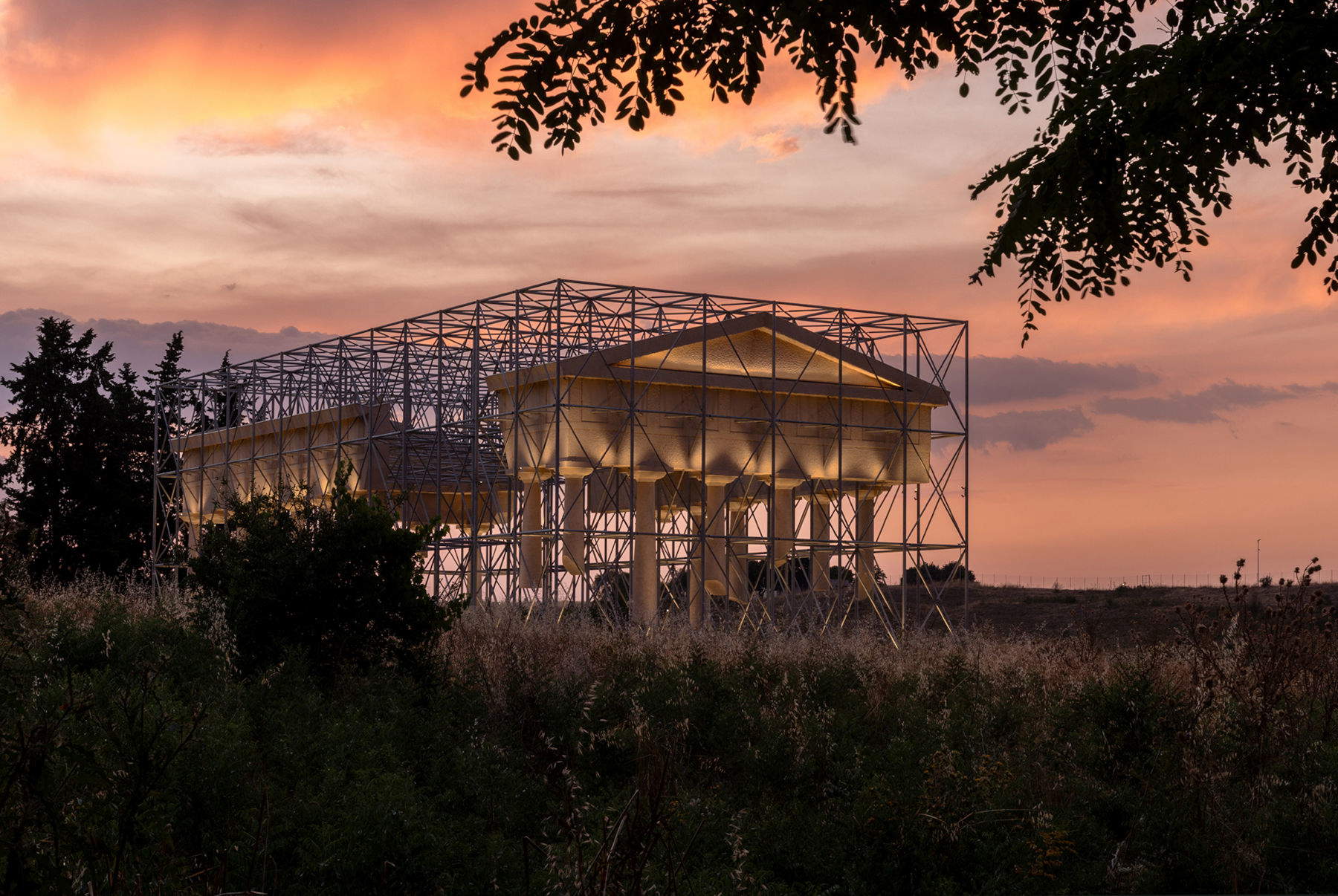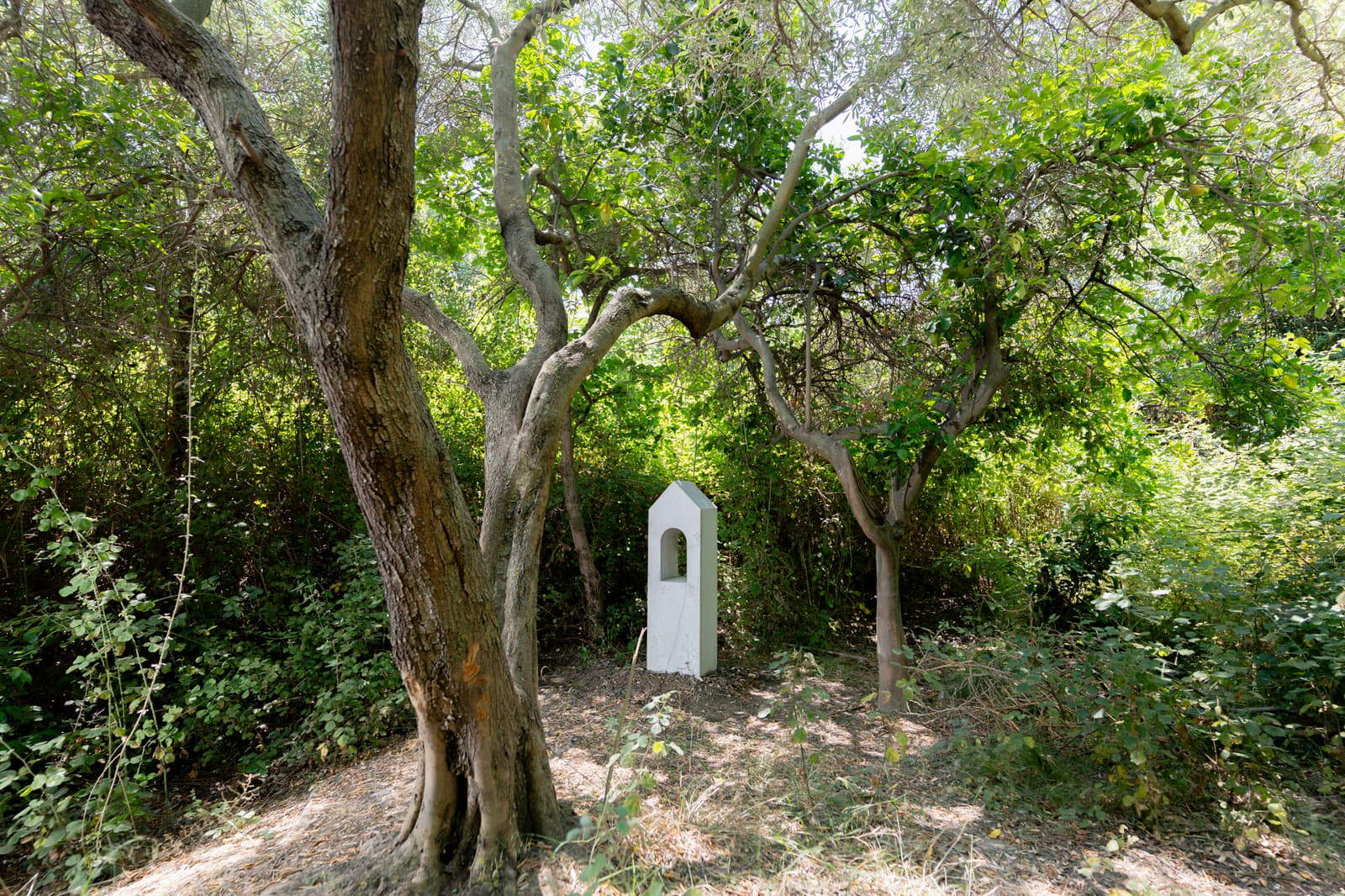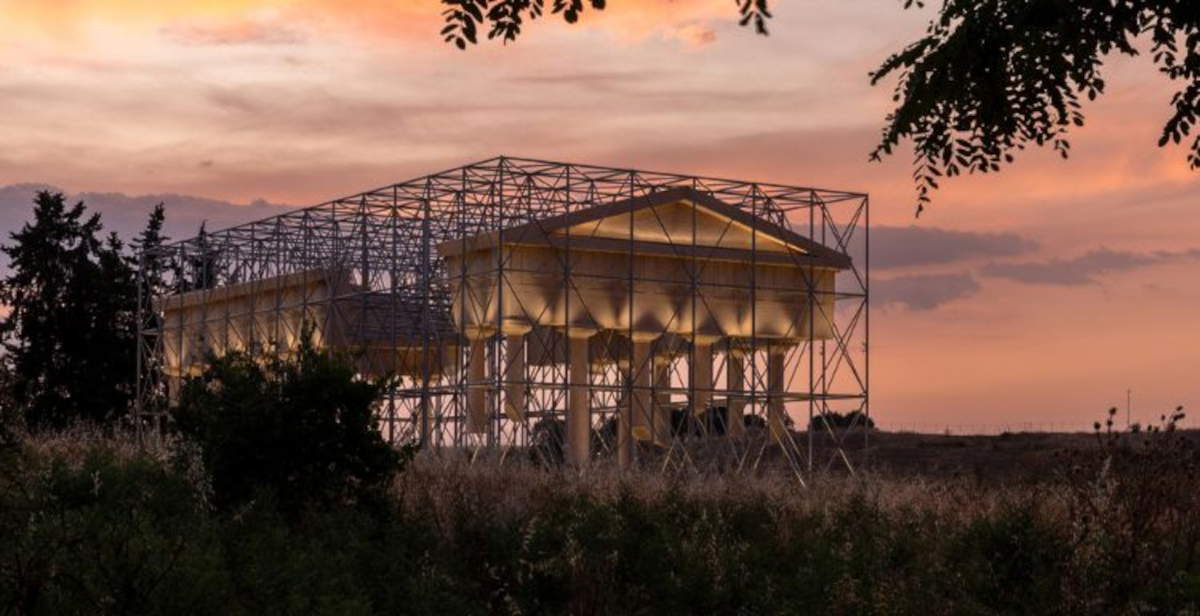Siris, the artistic enhancement project for the Archaeological Park of Herakleia in Policoro (Matera), curated by STUDIO STUDIO, the interdisciplinary laboratory founded by Edoardo Tresoldi, with the artistic direction of Antonio Oriente, was presented on Monday, November 10. The intervention involves three international artists, Gijs Van Vaerenbergh, Selva Aparicio and Max Magaldi, and is part of the program to enhance the sacred areas of the Park and the creation of the Archaeological Ecomuseum, promoted by the Ministry of Culture and financed with funds from the PON “Culture and Development” - ERDF 2014-2020.
The realization, supervised under the responsibility of architect Giuliano Zerillo, was managed by the Regional Secretariat for Basilicata of the Ministry of Culture, now merged into the Superintendence of Archaeology, Fine Arts and Landscape of Basilicata. The park, part of the network of National Archaeological Museums and Parks, holds important evidence of the Greek colonies that arose in the Ionian plain of Basilicata, such as the Archaic Temple and the Sanctuary of Demeter, which are now poorly legible due to their state of preservation. Siris is an experimental project that aims to make the historical and spiritual complexity of the site accessible even to a non-specialist public, through artworks capable of establishing a dialogue between archaeology, landscape and memory. The installations are reversible and non-invasive, designed to fit into the natural context without altering its integrity. The goal is to offer a layered narrative, balanced between ancient evidence, anthropological elements and contemporary dimensions.
The works represent a central element for the completion of the Archaeological Ecomuseum, designed to enhance the finds of the Greek colonies settled in the area since the seventh century B.C. and to strengthen the link between these presences, the nearby National Archaeological Museum of the Siritide and the surrounding area, which has been the subject of interventions aimed at improving its enjoyment.
“The Gijs Van Vaerenbergh’s idea for the Archaic Temple,” notes Antonio Oriente, artistic director of the Siris project for STUDIO STUDIO, “was already born during the first artistic residency in 2021, when with our working group we imagined weeks of total immersion in the local culture, trying to draw a timeline that would start from Magna Graecia and arrive up to today. In addition to the ability to interpret the volumes with an unprecedented key, the skillful contrast between the exact geometry of the metal structure and the chaotic explosion of the ruins, reversing the material presence was a very clever way both to leave visual space for the archaeological evidence and to ensure the reversibility of the intervention. The hinted forms return an idea of unfinishedness, the perception of the fragility of time that is not erased by restoration-the illusory evidence of the past-or by reconstruction-the illusory evidence of the present, but creates a new inhabitant of the Park, foreign and indigenous in the same place, disappeared and alive at the same time. With Selva Aparicio and Max Magaldi we wondered about demetriac rites, the legacy of ex votos and how these practices have transformed over time to the present day. We participated in arboreal rituals such as the ’May of Accettura,’ in order to know and experience as much as possible the Lucanian territory, also because I was born in Policoro and have always felt the burden and honor of doing work that lives up to the history of this place. Two different paths emerged but with numerous points of encounter. Max Magaldi leads us into a meta-phenomenological dimension that invites us to look and listen to what is happening outside and inside each of us, creating a timeless or out-of-time dimension, because everything written and composed could be part of any historical era or none in particular. Max, Claudia Fabris and Daniela Pes have become our ambassadors of the invisible: in a world where communication is becoming more and more intrusive and ubiquitous, they have succeeded in telling the non-visible without alienating the user from the context, because those who will take the musical and poetic journey composed especially for the Park will neither have to look at a screen nor isolate their hearing with headphones.”



The path unfolds in the Median Valley of the Park, where the three main works return the visitor to an immersive experience. The first is RovinaInversa by Belgian duo Gijs Van Vaerenbergh, which evokes the volumes of the Archaic Temple by reversing the natural process of dissolution of the ruins. The work, about twelve meters high, shows the upper part of the ancient building suspended in a metal lattice structure. The intervention takes the form of a conceptual reinterpretation of classical architecture, poised between reality and illusion, and is proposed as a new landmark in the Lucanian landscape.
The second installation, Chora by Spanish artist Selva Aparicio, is developed in the Sacred Forest of Demeter. The sculptural path consists of seven votive shrines made through botanical reliefs obtained from plants collected on site. The sculptures, intended to gradually merge with the vegetation, evoke the votive offerings of popular tradition and reflect on the relationship between devotion and nature. The last aedicule, placed near the ruins of the sanctuary, features a suspended bronze element that recalls the presence-absence of the goddess Demeter, inviting meditation on the threshold between physicality and spirituality.
The third intervention is Arbosonica, a sonification conceived by Max Magaldi with contributions from poet Claudia Fabris and musician Daniela Pes. The work uses a geolocated mapping system accessible through a dedicated app: soundtracks are activated as visitors pass by, integrating natural sounds and original compositions. The project explores the myth of Demeter and Persephone, an archetype of the life-death-rebirth cycle, transforming the Park into a sound organism in which voice, speech and environment merge. The use of technology, such as bone-conduction headphones that do not isolate from real sounds, allows for a perceptual experience in which landscape and composition overlap without artificial separations. In continuity with the project, Magaldi and Fabris created an educational workshop with students from the “Lorenzo Milani” school in Policoro, in collaboration with the Tower Art Museum in Matera, with the aim of strengthening the link between contemporary art and the territory.
Documenting the entire creative process is the film Siris directed by Giovanni Troilo, a director and photographer known for his work dedicated to contemporary art and archaeology. The documentary follows the stages of the project, from site surveys to the construction of the works, articulating into three chapters that interweave the perspectives of the different artists. Troilo explores the relationship between art, landscape and memory, restoring the complexity of the dialogue between past and present that runs throughout the project. Siris is configured as a choral experience in which different languages, architecture, sculpture and sound, meet in the landscape of the Archaeological Park of Herakleia. The works, although different in approach and medium, share the desire to bring back to life the sacred dimension of the place, transforming the archaeological site into a space for reflection on time, nature and the persistence of myth in the contemporary landscape.
Gijs Van Vaerenbergh is an architectural studio founded in 2007 in Leuven, Belgium, by the two architects Pieterjan Gijs and Arnout Van Vaerenbergh, who met during their university studies. The studio creates works of various scales, from urban installations and monuments to objects and sculptures, mixing technical and theoretical knowledge of architecture with experimentation related to the visual arts. Their work, marked by a strong spatial dimension, places the viewer’s experience and interaction with the context at the center, breaking disciplinary conventions and introducing artistic strategies to redefine the functional and formal aspects of architecture.
Selva Aparicio, born near Barcelona, is an interdisciplinary artist whose work investigates memory, intimacy and cycles of existence, often drawing inspiration from nature and the ephemeral. She holds a BFA from the School of the Art Institute of Chicago (2015) and an MFA in Sculpture from Yale University (2017). His works have been exhibited internationally at venues such as the Museum of Art and Design in New York, the Museum of Contemporary Art in Chicago, the Yale Center for British Art, and the Centre de Cultura Contemporanea in Barcelona. Among the awards he has received are the JUNCTURE Fellowship in Art and International Human Rights (2016), the Blair Dickinson Memorial Prize (2017), the Pritzker Pucker Family Foundation Artadia Award (2022), the Burke Prize from the Museum of Art and Design, New York (2023), and the Vilcek Prize for Creative Promise in Visual Arts (2025). His works are part of the permanent collections of the Museum of Contemporary Art in Chicago and the DePaul Art Museum. He recently completed his first permanent public commission for the Belgium Beaufort 2024 Triennial and is currently an assistant professor in the Department of Sculpture at Alfred University, New York.
Max Magaldi, an artist and musician, has collaborated with numerous musical projects in Europe. Since 2018, he has been combining music, contemporary art and digital hacking in performances on social networks. He has made installations and sound recordings in Italy, France, Greece and Saudi Arabia, also working with artists such as Edoardo Tresoldi and Studio Azzurro. Since 2021 he has been the creator and artistic director of the Memissima festival, dedicated to memetic culture.
Daniela Pes, a Sardinian musician and singer-songwriter born in Gallura in 1992, develops a music and voice that is difficult to label. Trained as a jazz singer at the Sassari Conservatory and the recipient of a scholarship to the Nuoro Jazz Summer Seminars directed by Paolo Fresu, she has performed at Time in Jazz and the Harp Festival in Rio de Janeiro. She has received major awards, including the Andrea Parodi Prize in 2017, with awards from critics, best music and best arrangement, and in 2018 awards for best music and Nuovoimaie at Musicultura. On April 14, 2023, she released her first studio album, Spira, produced by Iosonouncane, which earned her the Targa Tenco as Best First Work, the Rockol Award as Best Emerging Artist 2023, the Navicella Award, and in 2024 the Ballerino Dalla, Maria Carta, and Ciampi awards. In 2025 he is among the 15 MMEA nominations.
Giovanni Troilo is an award-winning filmmaker and photographer active in television, film and publishing. His visual style has appeared in international publications such as Newsweek, Der Spiegel, Repubblica, GQ, CNN, Wired and Wallpaper. Between 2012 and 2015 he directed ten documentaries on leading Italian photographers for Sky Arte. In 2015 his photography project La Ville Noire - The Dark Heart of Europe received recognition at the Sony World Photography Awards. His film works include Casanova Undressed (2016), William Kentridge - Triumphs and Laments (2016), selected at the Rome Film Festival, Monet’s Water Lilies (2018) and Frida Viva la Vida (2019), distributed in over 40 countries. His most recent projects include Vesuvius (2022), Power of Rome (2022) and Borromini and Bernini - Challenge to Perfection (2023). He is currently developing a new documentary series for Sky and working on his second feature film in Belgium. Since 2015 he has been artistic director of PhEST, an international visual arts festival in Monopoli.
 |
| From Tresoldi to Selva Aparicio, contemporary art at Herakleia Archaeological Park in Policoro |
Warning: the translation into English of the original Italian article was created using automatic tools. We undertake to review all articles, but we do not guarantee the total absence of inaccuracies in the translation due to the program. You can find the original by clicking on the ITA button. If you find any mistake,please contact us.